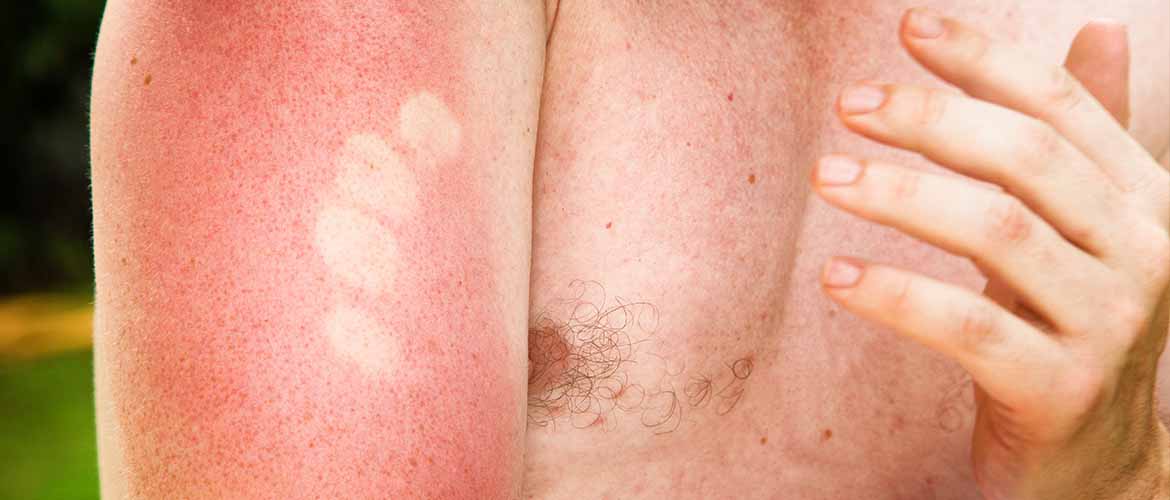June 6, 2018
Over-exposure to the sun can hit you on vacation, during recreation, and even on the move. Adverse health effects, both short and long term, can occur with sunburns of various severity, not to mention the possible early onset of wrinkling skin – ninety percent of which can be attributed to sun exposure.1 The best way to prevent future burns is to better understand them – from the moment those warm rays leave the atmosphere to the satisfying, or painful, moment they hit your skin.
Science of Sun

While it's important to monitor how long you're in the sun, some sun exposure and the vitamin D that comes from it, is good for you. Not only can sun exposure and vitamin D help boost your mood, they also promote bone growth and a healthy immune system. Though supplements can also be taken to increase your intake of vitamin D, the most direct way to boost your vitamin D supply is through direct exposure to the sun.
During that time, ultraviolet rays stimulate vitamin D synthesis in your skin, leading to the production of large amounts of the beneficial vitamin D. Exposing your skin to the sun for just half the time it takes for it to burn can actually lead to the healthy production of 10,000 to 25,000 IU (International Unit, used to measure potency) of vitamin D, though it varies by individual depending on your skin – darker skin may take several hours, while fair skin may take only 15 minutes.
But how does the sun work? NASA tells us that not only is the sun an incredible source of energy, but it also provides warmth through its infrared radiation and, of course, visible light. But it’s the source of light that we can’t see that’s the culprit for sunburns – ultraviolet light.2
The most common forms of UV radiation are UVA and UVB, which differ in wavelengths that permeate the skin, with UVA reaching further down into your epidermis, or the outermost layer of skin cells. Both can cause damage to the skin, but UVB is responsible for helping the skin produce that much-needed vitamin D. Both of these volatile, invisible rays can hit our skin cells, causing redness and pain, until the damaged cells die off. While the sun is the source of this type of energy, it can also be bounced off a number of surfaces, including water and even snow. Did you know? Just because the sun is tucked behind the clouds, it doesn’t mean you’re safe. Rather, up to 80 percent of ultraviolet rays permeate the clouds on an overcast day, leaving the unsuspecting person below with a sunburn.
After ongoing exposure to harmful rays, sunburn can ultimately leave you with the possibility of developing long-term, adverse complications like skin cancer, which is categorized as:
- Basal cell - typically found on the skin and curable, especially if diagnosed early. Appearance can vary but often noticed as a small, shiny bump or a sore that won’t heal
- Squamous cell - also typically found on the skin. Treatable if diagnosed early, though usually more aggressive; aesthetically noticeable as a crusty, scaly red area.
- Melanoma - can carry significant complications if malignant; may appear to be a dark, irregular, or changing mole. Melanoma impacts more than 50,000 people each year, with one in four being under the age of 40.3
- Pre-cancers - can develop on fair skin, particularly on those with chronic sun exposure. While not all pre-cancers, also known as actinic keratosis, will turn into squamous cell skin cancers, they can be easily identified by your health care provider and treated to lessen the chance that they will do so.
MedExpress Pro Tip: Performing routine checkups and regularly checking in with your doctor to identify these complications could prompt timely treatment and diagnosis if necessary.
The Scoop on Sunscreen

Whether you are hitting the beach or the pool, chances are you’ve been told several times to apply sunscreen to exposed skin. But why? How does the tropical-smelling lotion help protect your skin?
The two primary ingredients in sunscreen are zinc and titanium oxide, both of which naturally reflect UV rays. Other ingredients, like oxybenzone, dissipate the heat by absorbing it. Bottles often vary in their Sun Protection Factor (SPF), but the general rule of thumb is the higher the SPF, the more protection it offers. The FDA reminds users that the accompanying number does not refer to the time you can safely spend in the sun (e.g. SPF 15 does not correlate to 15 hours of sun safety). Rather, depending on your skin type and sensitivity, pick the SPF that best suits your needs, with 30-50 SPF recommend for those with fair skin.4
The CDC recommends applying sunscreen about 30 minutes before going into the sun to allow your body enough time to absorb the active ingredients in the sunscreen. It also needs reapplied after swimming or excessive sweating. The FDA doesn’t have a preference on whether to use lotion or aerosol cans to apply sunscreen, but they do warn against applying the latter near open flames as the contents of aerosol cans, including hairspray or insect repellants, are almost always flammable.5
MedExpress Pro Tip: Err on the side of caution and use sunscreen, even when you’re under an umbrella or out and about on an overcast day. It's better to be safe than sorry when it comes to those painful sunburns on you or your loved ones.
Code Red

When those sunny rays do hit your skin, it might not be immediately obvious depending on the severity of your burn. There might be times after an unexpected beach snooze or prolonged outdoor activity when it’s pretty obvious that you’ve got a sunburn. Warm red skin, anyone? It can be painful. But for the most part, the CDC states that symptoms usually kick in about four hours after sun exposure, with the pain settling in about six hours later. The next 24 hours can be tough with symptoms like swelling and blistering. Other unexpected, non-topical symptoms that often accompany those painful burns are headache, fever, nausea, and fatigue.
Severe symptoms and intense burns aren’t to be taken lightly. There are several instances during which it’s recommend to seek medical attention, including intense sunburns that cover more than 15 percent of your skin, a fever above 101 degrees Fahrenheit, and extreme, lingering pain.
And while your skin is your body’s largest organ, let’s not forget the two that give you a chance to see the effects of the beautiful sun. Protect your eyes! Those UV rays are liable to reflect off of nearby surfaces, including sand and water, leading to visual complications. A pair of sunglasses, particularly those labeled with UV ratings of 100 percent, can go a long way to protecting your eyes.
MedExpress Pro Tip: Drink up! Stay hydrated while you’re facing a bout of sunburn. A bit of aloe and a cool shower might also feel good on your inadvertently warm skin.
Age Isn't Just a Number

When it comes to UV rays, there are some demographics and audiences that are more susceptible to sunburn. We all know someone who seems to pick up an effortless glow and never burn, while others turn into a bright red tomato with over-exposure to the sun.
Sound familiar? If so, there’s a chance you might have photosensitivity, meaning the reaction set off by UV rays is an adverse one, giving you sunburn-like symptoms in just minutes. In other cases, though, it may simply be a reaction to a medication you’re taking or a topical product you use. Some of the more common items that could cause varying levels of sun sensitivity are antibiotics, chemotherapy drugs, and acne treatments, though their underlying cause is sometimes unknown due to their allergic or toxic basis.6 Even foods, like citrusy fruits or certain sweeteners, can trigger your sensitivity.
Sometimes, it’s simply a matter of which demographic you happen to fall in. Those in their elder years are particularly susceptible to sunburn for a number of reasons. According to the Skin Cancer Foundation, skin naturally undergoes changes that untimely weaken its defenses, which can included reduced immune systems, thinner skin, reduced healing capacity, and damage from things like pollution and smoking.
On the other end of the spectrum, babies and toddlers are also prone to the harmful effects of over-exposure. Whereas elderly skin has had years to mature and diminish, the delicate skin on your little one is less mature and hasn’t had the chance to toughen up. Instead of facing the sun, health professionals recommend keeping young ones in the shade or simply clothing them in lightweight, long-sleeved clothing. A healthcare professional should also be consulted before applying any sort of sunscreen on an infant.
MedExpress Pro Tip: Avoid direct sun between the hours of 10 a.m. and 3 p.m. when sunlight is often at its strongest overhead. It wouldn’t hurt to don a wide-brimmed hat and sunglasses, too.
References:
1 3 EPA: A Guide to the UV Index. Last updated May 2004. Accessed June 29, 2023.
2 NASA: Why Does The Sun Burn Us? Last updated Sept. 15, 2015. Accessed June 29, 2023.
4 FDA: Sunscreen: How to Help Protect Your Skin from the Sun. Last updated May 24, 2023. Accessed June 29, 2023.
5 FDA: Use Sunscreen Spray? Avoid Open Flame. Last updated Jan. 8, 2018. Accessed June 29, 2023.
6 Chemocare: What Are Skin Reactions? Accessed June 29, 2023.
